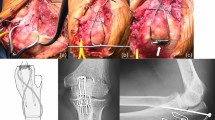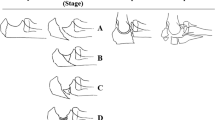Abstract
Purpose
The tension band wiring (TBW) technique is a common treatment for the fixation of olecranon fractures with up to three fragments. The literature and surgeons describe TBW as an uncomplicated, always available and convenient operation producing excellent results. The purpose of this study was to determine whether TBW is more ambitious than believed or the procedure provides an increased level of tolerance concerning the surgical technique.
Methods
This study reviewed 239 TBW cases in patients with olecranon fractures or osteotomies. We reviewed a total of 2,252 X-rays for ten operative imperfections: (1) nonparallel K-wires, (2) long K-wires, (3) K-wires extending radially outwards, (4) insufficient fixation of the proximal ends of the K-wires, (5) intramedullary K-wires, (6) perforation of the joint surface, (7) single wire knot, (8) jutting wire knot(s), (9) loose figure-of-eight configuration, and (10) incorrect repositioning.
Results
On average, there were 4.24 imperfections per intervention in the cases reviewed. A total of 1,014 of 2,390 possible imperfections were detected. The most frequent imperfections were insufficient fixation of the proximal ends of the K-wires (91 % of all cases), the use of a single wire knot (78 %) and nonparallel K-wires (72 %). Mayo IIa (n = 188) was the most common fracture type.
Conclusions
Our results and the number of complications described by the literature together support the conclusion that TBW is not as easy as surgeons and the literature suggest. Although bone healing and the functional results of TBW are excellent in most cases, the challenges associated with this operation are underestimated.
Level of Evidence: IV, treatment study










Similar content being viewed by others
References
Chalidis BE, Sachinis NC, Samoladas EP et al (2008) Is tension band wiring technique the “gold standard” for the treatment of olecranon fractures? A long term functional outcome study. J Orthop Surg Res 22:3–9
Helm RH, Hornby R, Miller SWM (1987) The complications of surgical treatment of displaced fractures of the olecranon. Injury 18(1):48–50. doi:10.1016/0020-1383(87)90386-X
Macko D, Szabo RM (1985) Complications of tension-band wiring of olecranon fractures. J Bone Joint Surg Am 67(9):1396–1401
Karlsson MK, Hasserius R, Karlsson C et al (2002) Fractures of the olecranon: a 15- to 25-year followup of 73 patients. Clin Orthop Relat Res 403:205–212. doi:10.1097/00003086-200210000-00030
Murphy DF, Greene WB, Gilbert JA et al (1987) Displaced olecranon fractures in adults. Biomechanical analysis of fixation methods. Clin Orthop Relat Res 224:210–214
Karlsson MK, Hasserius R, Besjakov J et al (2002) Comparison of tension-band and figure-of-eight wiring techniques for treatment of olecranon fractures. J Shoulder Elbow Surg 11(4):377–382. doi:10.1067/mse.2002.124548
Holdsworth BJ, Mossad MM (1984) Elbow function following tension band fixation of displaced fractures of the olecranon. Injury 16(3):182–187. doi:10.1016/0020-1383(84)90156-6
Horne JG, Tanzer TL (1981) Olecranon fractures: a review of 100 cases. J Trauma 21(6):469–472
Rommens PM, Küchle R, Schneider RU et al (2004) Olecranon fractures in adults: factors influencing outcome. Injury 35(11):1149–1157. doi:10.1016/j.injury.2003.12.002
Van der Linden SC, Van Kampen A, Jaarsma RL (2012) K-wire position in tension-band wiring technique affects stability of wires and long-term outcome in surgical treatment of olecranon fractures. J Shoulder Elbow Surg 21(3):405–411. doi:10.1016/j.jse.2011.07.022
Guitton TG, Zurakowski D, van Dijk NC et al (2010) Incidence and risk factors for the development of radiographic arthrosis after traumatic elbow injuries. J Hand Surg [Am] 35(12):1976–1980
Lee SH, Han SB, Jeong WK et al (2010) Ulnar artery pseudoaneurysm after tension band wiring of an olecranon fracture resulting in Volkmann’s ischemic contracture: a case report. J Shoulder Elbow Surg 19(2):e6–8. doi:10.1016/j.jse.2009.06.007
Parker JR, Conroy J, Campbell DA (2005) Anterior interosseus nerve injury following tension band wiring of the olecranon. Injury 36(10):1252–1253. doi:10.1016/j.injury.2004.12.028
Thumroj E, Jianmongkol S, Thammaroj J (2005) Median nerve palsy after operative treatment of olecranon fracture. J Med Assoc Thai 88(10):1434–1437
Korner J, Josten C, Lill H (2001) Kapitel 10: Olekranonfrakturen. In: Josten C, Lill H (eds) Ellenbogenverletzungen, vol 1, Auflage. Steinkopff-Verlag, Darmstadt, pp 151–161
Ilahi OA, Strausser DW, Gabel GT (1998) Post-traumatic heterotopic ossification about the elbow. Orthopedics 21(3):265–268
Velkes S, Tytiun Y, Salai M (2005) Proximal radio-ulnar synostosis complicating tension band wiring of the fractured olecranon. Injury 36(10):1254–1256. doi:10.1016/j.injury.2004.12.034
Gartsman GM, Sculco TP, Otis JC (1981) Operative treatment of olecranon fractures. Excision or open reduction with internal fixation. J Bone Joint Surg Am 63(5):718–721. doi:10.1016/j.jhsa.2010.08.010
Papagelopoulos PJ, Morrey BF (1994) Treatment of nonunion of olecranon fractures. J Bone Joint Surg Br 76(4):627–635
Morrey BF (1995) Current concepts in the treatment of fractures of the radial head, the olecranon, and the coronoid. J Bone Join Surg Am 77(2):316–327
Hak DJ, Stewart RL (2008) Prinzip der Zuggurtung. In: Rüedi TP, Buckley RE, Moran CG (eds) AO-Prinzipien des Frakturmanagements, vol 2, Auflage. Georg Thieme Verlag KG, Stuttgart, pp 249–254
Candal-Couto JJ, Williams JR, Sanderson PL (2005) Impaired forearm rotation after tension-band-wiring fixation of olecranon fractures: evaluation of the transcortical K-wire technique. J Orthop Trauma 19(7):480–482. doi:10.1097/01.bot.0000164338.79013.10
Mullett JH, Shannon F, Nöel J et al (2000) K-wire position in tension band wiring of the olecranon—a comparison of two techniques. Injury 31(6):427–431. doi:10.1016/S0020-1383(00)00014-0
Wu C-C, Tai C-L, Shih C-H (2000) Biomechanical comparison for different configurations of tension band wiring techniques in treating an olecranon fracture. J Trauma 48(6):1063–1067. doi:10.1097/00005373-200006000-00011
Deliyannis SN (1973) Comminuted fractures of the olecranon treated by the Weber-Vasey technique. Injury 5(1):19–24. doi:10.1016/S0020-1383(73)80004-X
Fyfe IS, Mossad MM, Holdsworth BJ (1985) Methods of fixation of olecranon fractures. An experimental mechanical study. J Bone Joint Surg Br 67(3):367–372
Mauffrey C, Krikler S (2009) Surgical techniques: how I do it? Open reduction and tension band wiring of olecranon fractures. Injury 40(4):461–465. doi:10.1016/j.injury.2008.09.026
Jensen CM, Olsen BB (1986) Drawbacks of traction-absorbing wiring (TAW) in displaced fractures of the olecranon. Injury 17(3):174–175. doi:10.1016/0020-1383(86)90326-8
Netz P, Strömberg L (1982) Non-sliding pins in traction absorbing wiring of fractures: a modified technique. Acta Orthop Scand 53(3):355–360. doi:10.3109/17453678208992228
Hume MC, Wiss DA (1992) Olecranon fractures. A clinical and radiographic comparison of tension band wiring and plate fixation. Clin Orthop Relat Res 285:229–235
Catalano LW III, Crivello K, Lafer MP et al (2011) Potential dangers of tension band wiring of olecranon fractures: an anatomic study. J Hand Surg [Am] 36(10):1659–1662. doi:10.1016/j.jhsa.2011.07.001
De Carli P, Gallucci GL, Donndorff AG et al (2009) Proximal radio-ulnar synostosis and nonunion after olecranon fracture tension-band wiring: a case report. J Shoulder Elbow Surg 18(3):e40–44. doi:10.1016/j.jse.2009.02.005
Rompen JC, Vos GA, Verheyen CC (2010) Acute ischemia of the hand seven months after tension-band wiring of the olecranon. J Shoulder Elbow Surg 19(3):e9–11. doi:10.1016/j.jse.2009.10.009
Wolfgang G, Burke F, Bush D et al (1987) Surgical treatment of displaced olecranon fractures by tension band wiring technique. Clin Orthop Relat Res 224:192–204
Villanueva P, Osorio F, Commessatti M et al (2006) Tension-band wiring for olecranon fractures: analysis of risk factors for failure. J Shoulder Elbow Surg 15(3):351–356. doi:10.1016/j.jse.2005.08.002
Romero JM, Miran A, Jensen CH (2000) Complications and re-operation rate after tension-band wiring of olecranon fractures. J Orthop Sci 5(4):318–320. doi:10.1007/s007760070036
Brink PR, Windolf M, de Boer P et al (2013) Tension band wiring of the olecranon: is it really a dynamic principle of osteosynthesis? Injury 44(4):518–522. doi:10.1016/j.injury.2012.08.052
Author information
Authors and Affiliations
Corresponding author
Additional information
Marco M. Schneider and Tobias E. Nowak contributed equally as co-first authors.
Rights and permissions
About this article
Cite this article
Schneider, M.M., Nowak, T.E., Bastian, L. et al. Tension band wiring in olecranon fractures: the myth of technical simplicity and osteosynthetical perfection. International Orthopaedics (SICOT) 38, 847–855 (2014). https://doi.org/10.1007/s00264-013-2208-7
Received:
Accepted:
Published:
Issue Date:
DOI: https://doi.org/10.1007/s00264-013-2208-7




